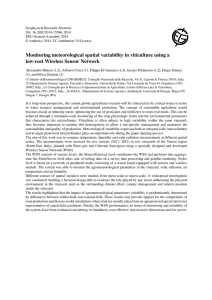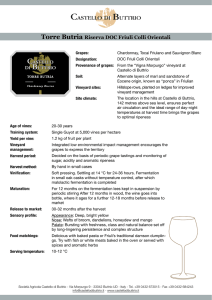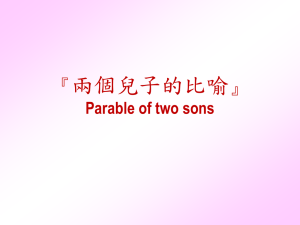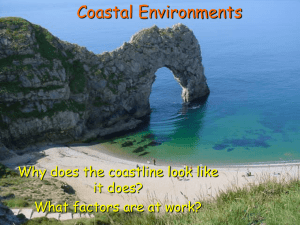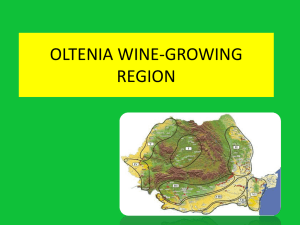Central Coast Vineyard Team - Sustainable Agriculture Research
advertisement
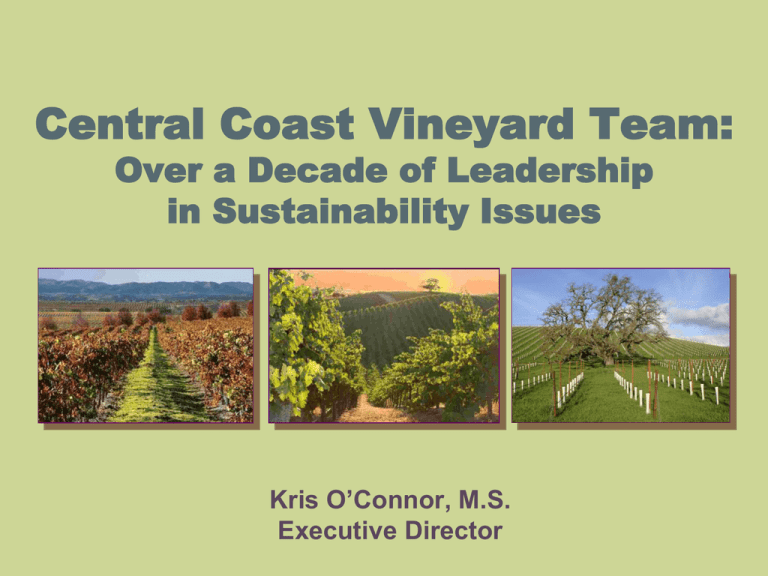
Central Coast Vineyard Team: Over a Decade of Leadership in Sustainability Issues Kris O’Connor, M.S. Executive Director Central Coast Vineyard Team Background • • • • Collaborative Partnership Non-profit Grower Group Broad and Diverse Group Need for more progressive information • Limited information specific to Central Coast • Desire to “push” the envelope CENTRAL COAST VINEYARD TEAM Mission Statement The Central Coast Vineyard Team will identify and promote the most environmentally safe, viticulturally and economically sustainable farming methods, while maintaining or improving quality and flavor of wine grapes. The Team will be a model for wine grape growers and will promote the public trust of stewardship for natural resources. Our Values Conservation • Innovation • Learning • Sharing • Integrity CENTRAL COAST VINEYARD TEAM Positive Points System Foundation of Programs What is the PPS? • 1,000-point protocol for evaluating the extent of sustainable practices • Soil, Water, Pest, Viticulture Management & Wine Quality and Human Resources • Whole farm, “systems” approach CENTRAL COAST VINEYARD TEAM Positive Points System Purpose Educational Tool—educate and guide growers towards more sustainable practice • • • • Identify areas of strength and weakness Provides “How-To” information Document adoption of practices Process is educational CENTRAL COAST VINEYARD TEAM Positive Points System Results • • • • • 750 evaluations collected since 1996 Over 30,000 evaluated acres Continuing growers have higher scores than 1st year grower Scores on a given block are improving Overall scores increasing over time CENTRAL COAST VINEYARD TEAM From Assessment to Education Grower to Grower Outreach • • • • • • • • • Newsletters Resource Library Tailgate Meetings Workshops Spanish Outreach PPS Wall Calendar Annual Educational Meetings Sustainable Ag Expo Support Growers in Participating in Conservation Funding Programs CENTRAL COAST VINEYARD TEAM From Education to Demonstration – Biologically Integrated Farming • Intensive weekly monitoring and recording • Action plans based on target pest and material • Reduce or eliminate high risk, broad spectrum materials • Alternative weed practices • Alternative, low risk materials • Beneficial releases, insectary refuge, compost, cover crops • Tolerate higher pest levels CENTRAL COAST VINEYARD TEAM Changes in PPS Scores BIFS vs. Non-BIFS Growers (2002 – 2004) 893 900 Average PPS Score 880 860 840 820 819 818 796 800 780 760 740 BIFS (N=9) CENTRAL COAST Non-BIFS (N=26) VINEYARD TEAM 2002 2004 BIFS FQPA I Contact Herbicide Use (paraquat dichloride) 100 90 80 70 ZBL - PARAQUAT DICHLORIDE WLF - PARAQUAT DICHLORIDE SJN - PARAQUAT DICHLORIDE PCV - PARAQUAT DICHLORIDE CRL - PARAQUAT DICHLORIDE CHB - PARAQUAT DICHLORIDE CHA - PARAQUAT DICHLORIDE CCA - PARAQUAT DICHLORIDE BNC - PARAQUAT DICHLORIDE EIQ Per Acre 60 50 40 30 20 10 0 2002 2003 2004 Year CENTRAL COAST VINEYARD TEAM Central Coast Winegrape Pesticide Use Lbs AI/Planted Acre Chlorpyrifos Diazinon 0.20 ≈ 18,000 Lbs AI 0.15 0.10 ≈ 7,200 Lbs AI 0.05 0.00 1993 1998 1999 Source: DPR PUR 1993 - 2003 CENTRAL COAST 2000 2001 Year VINEYARD TEAM 2002 2003 BIFS Pesticide Use Chlorpyrifos & Diazinon Per Acre Basis BNC - CHLORPYRIFOS SJN - DIAZINON BNC - DIAZINON WLF - CHLORPYRIFOS CHA - CHLORPYRIFOS SJN - CHLORPYRIFOS 8 7 Total Lbs Applied/Acre 6 5 4 3 2 1 0 2002 2003 2004 Year CENTRAL COAST VINEYARD TEAM Pesticide Use BIFS vs. Central Coast (lbs/ac) 71.0 75.0 80 61.2 70 32.1 20.7 11.4 11.3 20.4 16.8 22.0 14.1 6.4 8.9 7.0 5.1 0.7 5.2 3.9 5.3 6.0 3.8 16.0 13.1 16.6 10 19.1 16.0 2002 CC Regional AI/Ac = 36.8 lbs/ac 20 42.6 45.9 20.9 21.5 30 2003 CC Regional AI/Ac = 39.6 lbs/ac 6.3 40 30.3 50 40.7 Applied AI (Lbs/Block Acre) 60 0 BNC CCA CHA CHB CRL CST PCV RLS SJN BIFS Block CENTRAL COAST VINEYARD TEAM WLF ZBL 2002 2003 2004 Clean Water Project: Reducing NPS Pollution from Vineyards • Goal – Demonstrate practices that reduce NonPoint Source (NPS) pollution from Central Coast Vineyards • Watersheds listed for agriculturally linked impairments: nutrients, sediment, pesticides CENTRAL COAST VINEYARD TEAM Demonstration Site Results: Paso Robles Native filter strip (pine blues grass, Nodding needle grass, purple needle grass) Buckwheat • • • • • BMP: Plant cover crop & native filter strip Initial cost/acre: app. $300.00 Estimated Soil Loss w/out BMP = 24.50 tons/ac/yr Estimated Soil Loss WITH BMP = 0.90 tons/ac/yr Est. decrease in soil loss = 23.60 tons/ac/yr CENTRAL COAST VINEYARD TEAM Demonstration Site Results: Santa Maria Cover crop (tall and sheep’s fescue) • BMP: Grade, plant cover crops and secure with jute netting • Initial cost/acre: app. $200.00 • Estimated Soil Loss w/out BMP = 32.50 tons/ac/yr • Estimated Soil Loss WITH BMP = 0.75 tons/ac/yr • Est. decrease in soil loss = 31.5 tons/ac/yr CENTRAL COAST VINEYARD TEAM Highlights of Vineyard Oak Conservation • Cuesta Ridge Vineyards • Significant set aside • Planting efforts in additional areas • Not one tree was removed for vineyard development CENTRAL COAST VINEYARD TEAM Luft Vineyards • Set aside area around oak corridor • Planting additional area with Cal Poly & CCVT • 2007 Tailgate to highlight restoration area CENTRAL COAST VINEYARD TEAM James Berry Vineyards • 1982 Conservation plan with NRCS (SCS) • 10 acres of oak woodland conservation • Refuge for anagrus, birds, wildlife • Highlighted at tailgates CENTRAL COAST VINEYARD TEAM Highlighting Grower Practices through Education • Newsletter Articles • Highlight Grower Practices • Oak Workshops (Southcorp Vineyard - 2001) • 2 Day with UCCE • Included planting efforts • Safe Harbor Meeting (Cuesta Ridge - 2004) • Reviewed development, planting, and wildlife issues • EcoSystem Workshops (2006) • Coordinated with Statewide Efforts CENTRAL COAST VINEYARD TEAM Current Projects • Pesticide Mitigation • Continuation of BIFS • Focusing on reducing pesticides that impact water quality • Cover Crop and Water Quality • Continuation of CWP • Evaluation of 20 cover crops in SB and SLO county • Evaluation of runoff measurement devices – comparison to estimated/modeled values CENTRAL COAST VINEYARD TEAM Environmental & Regulatory Recognition • IPM Innovator Award from the Department of Pesticide Regulation • Environmental Stewardship Award – SLO Community Foundation • Water Quality Award - RWQCB • EPA Champion • PPS Modeled by Statewide Sustainability Efforts in Winegrapes CENTRAL COAST VINEYARD TEAM New Programs New Water Quality Grant 2007-09 On-Line Resource Library CENTRAL COAST VINEYARD TEAM Looking Forward Certified Sustainable Standards • • • • Conversion of PPS to Standards Peer review – independently verified Pilot project this year Outreach to growers, wineries, consumers, and trade • Business plan – earned income ventures • Focus groups and marketing research CENTRAL COAST VINEYARD TEAM Looking Forward • Bridge gap with consumers • Bridge gap with other ag producers • Build foundation for community supporters and certified sustainably grown products CENTRAL COAST VINEYARD TEAM Our Unique Position to Affect the “Culture” of Farming and Positively Affect Decision Makers • • • • • • • • • Grass-roots, grower led PPS Able to Adapt Committed Core Group Grower “Buy-In” Community “Buy-In” On-Farm Implementation Bilingual Program Community Connection Decision-Maker Connection Our Values Conservation • Innovation • Learning • Sharing • Integrity CENTRAL COAST VINEYARD TEAM Questions? CENTRAL COAST VINEYARD TEAM

